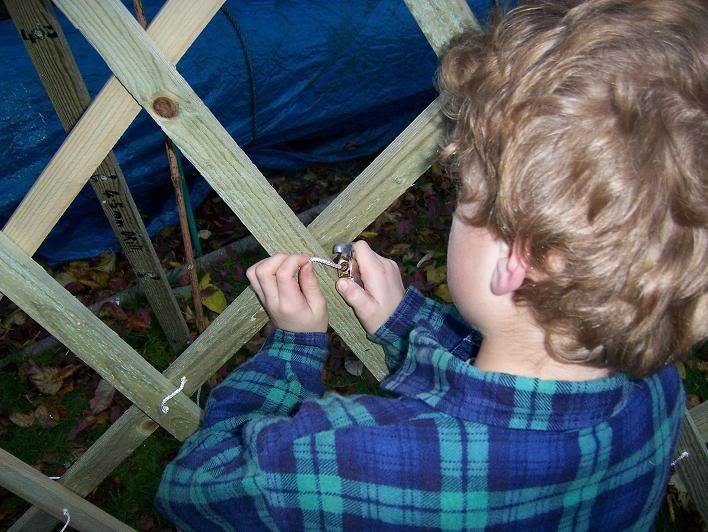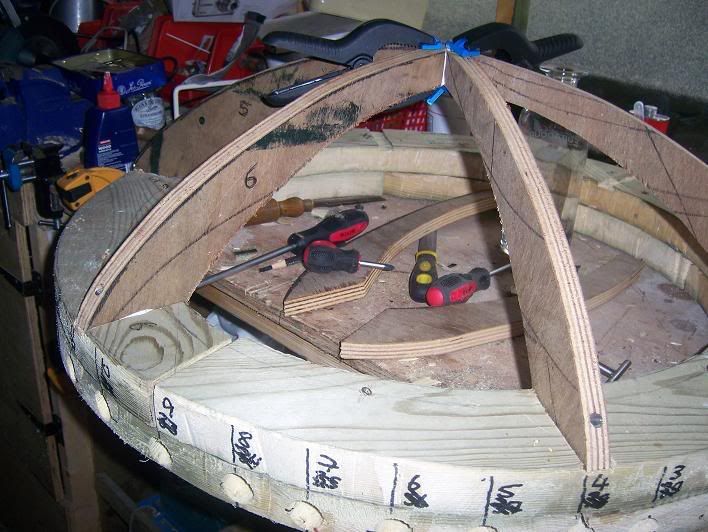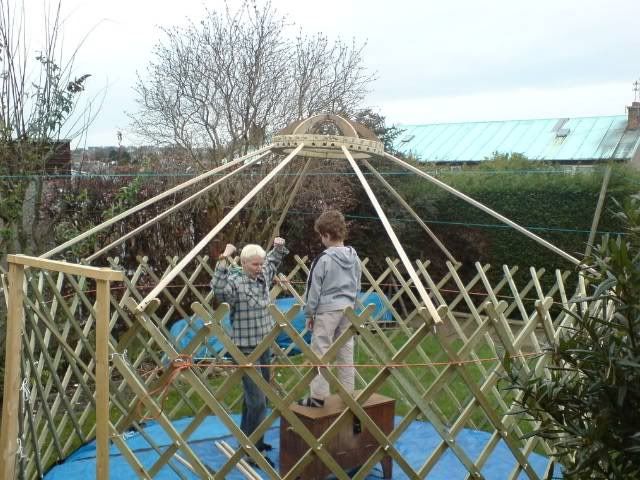Yurt - so far
- Thread starter JohnC
- Start date
You are using an out of date browser. It may not display this or other websites correctly.
You should upgrade or use an alternative browser.
You should upgrade or use an alternative browser.
Eric_Methven
Bushcrafter (boy, I've got a lot to say!)
I'm afraid its Homebase cheap stuff. I had plans of coppiced hazel, but time wore on and we got under way with what we had, either from skips, homebase or lying around the shed. If I started again, I'd try for thinner lats of wood.

So far its been a great project, Joe's a dab hand at sealing the cord ends

My yurt book talked about beautifully finished central wheels, mine will need some paint...

So far its been a great project, Joe's a dab hand at sealing the cord ends

My yurt book talked about beautifully finished central wheels, mine will need some paint...
Great job, and a fun project.
Just be careful with your top "tension band". That's the rope/cable/wire that runs around the top of the side walls. It holds everything up and in place. You REALLY NEED to pay attention to that tension band. If it stretches or breaks, then the walls push out and the "roof" comes down on you.
Rope can work, but it also has a tendency to stretch. Most people nowdays use steel cable. But some have had good luck using nylon webbing - after dealing with the stretching.
That cover does not have to be in one large piece. Smaller sections that overlap are easier to work with. And it is really nice to make the cover for the very peak as a separate piece - where it covers your "wheel". If you tie ropes onto the 4 corners of that cover, you can "pull" it up into place and hold it there. But you can also then pull/slide it out of the way so that you can ... see the stars ... plus vent heat/smoke etc.
I really love the round room you end up with - and without any inside poles to support things. The only tricky part then is to adjust your thinking to working in a round room instead of a normal square/rectangular space. Some have a hard time making that mental adjustment.
Just my humble thoughts to share. Take them as such.
Mikey - yee ol' grumpy blacksmith out in the Hinterlands
Just be careful with your top "tension band". That's the rope/cable/wire that runs around the top of the side walls. It holds everything up and in place. You REALLY NEED to pay attention to that tension band. If it stretches or breaks, then the walls push out and the "roof" comes down on you.
Rope can work, but it also has a tendency to stretch. Most people nowdays use steel cable. But some have had good luck using nylon webbing - after dealing with the stretching.
That cover does not have to be in one large piece. Smaller sections that overlap are easier to work with. And it is really nice to make the cover for the very peak as a separate piece - where it covers your "wheel". If you tie ropes onto the 4 corners of that cover, you can "pull" it up into place and hold it there. But you can also then pull/slide it out of the way so that you can ... see the stars ... plus vent heat/smoke etc.
I really love the round room you end up with - and without any inside poles to support things. The only tricky part then is to adjust your thinking to working in a round room instead of a normal square/rectangular space. Some have a hard time making that mental adjustment.
Just my humble thoughts to share. Take them as such.
Mikey - yee ol' grumpy blacksmith out in the Hinterlands
The traditional way of tensioning...well really it's just holding it snug, is to wrap a band, the belly band, of tightly woven braid at least 6inches wide around that top edge.
I was asked if I would help a friend weave one for her yurt but after 5 foot she'd had enough
In the end we used a band made of doubled canvas fabric, with re-inforced eyelets stitched in to tie the band to the door frames.
Three years down the line the band is working perfectly and the yurt is more or less permanently up.
I'd never have thought of using steel cables tbh, do they not cut into the lattice ?
Not a criticism Mike, just genuinely interested; seriously thinking of having a go at a geodesic dome since I know I don't have room for the yurt and it's poles in my car.
cheers,
Mary
I was asked if I would help a friend weave one for her yurt but after 5 foot she'd had enough
In the end we used a band made of doubled canvas fabric, with re-inforced eyelets stitched in to tie the band to the door frames.
Three years down the line the band is working perfectly and the yurt is more or less permanently up.
I'd never have thought of using steel cables tbh, do they not cut into the lattice ?
Not a criticism Mike, just genuinely interested; seriously thinking of having a go at a geodesic dome since I know I don't have room for the yurt and it's poles in my car.
cheers,
Mary
Looking good John 
Yurts or 'jurta' are fairly common over here (Hungary).
Hungarian yurts appear to be less wide and taller than the ones found in Mongolia, an old drawing can be found near the bottom of this page...
http://www.lovaspark.hu/hu_index.php?page=hatter
And here is a series of step by step photographs showing a Mongolian yurt being assembled.
http://www.feketesolyom.sk/doc/A MONGOL JURTA.htm
Yurts or 'jurta' are fairly common over here (Hungary).
Hungarian yurts appear to be less wide and taller than the ones found in Mongolia, an old drawing can be found near the bottom of this page...
http://www.lovaspark.hu/hu_index.php?page=hatter
And here is a series of step by step photographs showing a Mongolian yurt being assembled.
http://www.feketesolyom.sk/doc/A MONGOL JURTA.htm
Eric_Methven
Bushcrafter (boy, I've got a lot to say!)
Tensioning straps designed to hold down heavy loads on wagons work well as a belly band, and they have the tightening gizmo built in too so you can adjust the tension perfectly. Old car seat belts stitched end to end also work.
I never thought of using roofing laths for the khana John. Are you using them straight and letting the shape of the yurt bend them, or have you steamed them beforehand?
Eric
I never thought of using roofing laths for the khana John. Are you using them straight and letting the shape of the yurt bend them, or have you steamed them beforehand?
Eric
Thanks for the comments and advice... I've only used a bit of spare orange rope so far, but hope to use something along the lines of a canvas band as well as a rope. I've got a bunch of old judo belts that I though I may recycle, but I need to check if they stretch. The seat belt idea is great, may be able to get them from the scrapyard.
The lats of wood are straight, but the wall has this lovely curve inwards..
The lats of wood are straight, but the wall has this lovely curve inwards..
I'd never have thought of using steel cables tbh, do they not cut into the lattice ?
Not a criticism Mike, just genuinely interested; seriously thinking of having a go at a geodesic dome since I know I don't have room for the yurt and it's poles in my car.
cheers,
Mary
Steel cable won't really cut in any more than heavy rope - either natural or nylon. Yes, it would be better to have a flat and wide strap. That spreads the "pressure points" out. But there should be no extra worry on each piece of lattice - do to the sharing the force over many smaller areas. The more pieces of lattice that are being held in by the tension band, the less tension on each one individually. If it becomes a concern, you can always put a small metal plate on top of the individual laths to help spread out and resist the pressure.
A geodesic dome? TINKERTOY HEAVEN! Yes, you get lots of small or short pieces, but spend more time fitting it all together - even with some sections left whole in transit. They are great in bad weather, and very strong. But one note: when you go larger than that half-sphere, you start losing floor space while gaining extra "head room" that is hard to utilize.
I did a little research on modern interpretations of yurts a few years ago - as in building them yourself, and to use as permanent homes and shops/offices. I really liked the Concentric Yurt - a 12 foot diameter yurt built up on a raised deck 7 to 8 feet high, and then with another whole outside wall/roof running all the way around it - a 20 foot diameter. The outside walls were made of solid boards, leaned outward, and had benches built in all around them for sitting and storage. You ended up with that large round room on the "second story", the room underneath that room/deck for household utilities (kitchen and bathroom), and that outside ring to use for bedrooms, office space, storage, running track for kids, etc.
And then there was that LOG yurt. Interesting buildings indeed!
And they can make pretty fun temporary tents. If you drill and rivet your laths carefully, you can make them in short sections that can be folded up pretty small - kind of like an accordian, or a kid's safety gate to put into a door. When you pull them apart to expand them, they become fairly easy to bend/curve into a section of your circular wall. There should not be any need to "pre-bend" things. The biggest pieces to worry about are the door and its frame, and that central "wheel".
That central "wheel" in the peak ends up being a matter of personal choice. It's nice to have it big enough to act as a skylight. But that comes with a lot more bulk and weight in packing. Some people just have a small hub to set the ends of their roof poles in, and then cover over it completely with their canvas roof pieces. But most have that larger "wheel". And if they want to put a stove inside, it makes a good place to run the stove pipe up through.
There is/was and old book put out years ago by the people who wrote up the Whole Earth Catalog - called Shelter. It has a lot of good info and contacts on all things concerning shelter - temporary, traveling, and permanent. Because of how old it is, some of the contact info probably is no longer valid.
Yes, I do like yurts - in the right situations. Ditto my tipi.
Mikey - yee ol' grumpy blacksmith out in the Hinterlands
p.s. I love your ... flexible rivets ... for holding the laths together! And so simple - just nylon cord knotted, and run through a hole in each board. Loose bolts or iron rivets might give you a tad more strength, but they add to the weight and decrease the "flexibility".
I borrowed this dome from a friend for one of our meet ups
http://www.artgalore.co.uk/GeoffForrest.html
see the bottom of the page.
It honestly was quicker to take down than a yurt and I'm assured that once the pieces are familiar it goes up just as quickly.
I do like the right to the eaves headroom of the yurt though, and I do much prefer the doorway too.
cheers,
Toddy
http://www.artgalore.co.uk/GeoffForrest.html
see the bottom of the page.
It honestly was quicker to take down than a yurt and I'm assured that once the pieces are familiar it goes up just as quickly.
I do like the right to the eaves headroom of the yurt though, and I do much prefer the doorway too.
cheers,
Toddy
Now i wanna make one prbably 10 feet diameter and ill probably live in it...thanks for the inspiration!!
I didnt know what yurt was until I looked on this thread. Infact I thought you were building a mock spaceship until I saw the door on the front! It looks fantastic anyway, (even if it isnt going to fly!) It's amazing what can be accomplished in even just the small space of a backgarden.
Similar threads
- Replies
- 12
- Views
- 265
- Replies
- 3
- Views
- 430
- Replies
- 18
- Views
- 565


 Well impressed
Well impressed